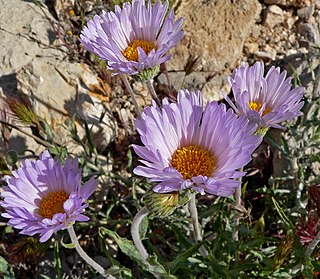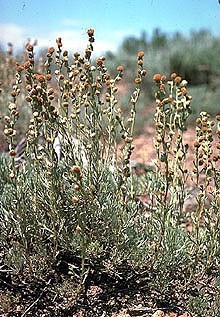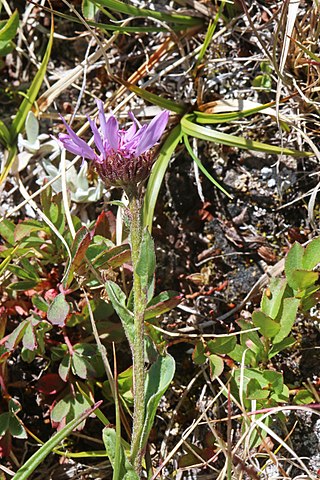Erigeron abajoensis, the Abajo fleabane, is a species of Erigeron in the family Asteraceae. It is native to Utah in the western United States, and has been found also in neighboring parts of Arizona, Colorado, and New Mexico. It grows on sunny, dry, rocky slopes generally at elevations of 2,270 to 3,400 meters.

Limnocharitaceae was a family of flowering plants in the monocot order Alismatales. In the APG IV system, it is included in the family Alismataceae. It is commonly known as the water poppy family. Species that have been placed in this taxon are small, perennial, aquatic herbs, native to the tropics, but adventive or naturalized in the subtropics as a result of cultivation.

Allium cernuum, known as nodding onion or lady's leek, is a perennial plant in the genus Allium. It grows in open areas in North America.

Astragalus lemmonii, the Lemmon's milkvetch, is a rare plant of eastern California. It is a member of the bean family, the Leguminosae, and specifically a member of the subfamily Papilionoideae. The genus Astragalus is a large genus within this family; members of this genus are known as milkvetches or locoweeds. Close relatives of this particular species include Astragalus peckii and Astragalus lentiformis.

Xylorhiza is a genus of flowering plants in the family Asteraceae, known as woodyasters. These are daisylike wildflowers usually having blue to purple or white ray flowers with yellow centers of disc florets. Woodyasters are native to western North America.

Allium atrorubens is a species of wild onion known by the common name dark red onion. This plant is native to the southwestern United States where it grows in the sandy soils of the Mojave Desert, the Great Basin and higher-elevation deserts in Nevada, eastern California southwestern Utah, northwestern Arizona.

Allium nevadense is a species of wild onion known by the common name Nevada onion. It is native to the western United States where it grows in sand and rocky soil at elevations of 1400–1700 m. The species is widespread in Utah, Nevada and southern Idaho, and has been reported also from southeastern California, northwestern Arizona, western and central Colorado and eastern Oregon.

Scoliopus, or fetid adderstongue, is a genus of plant within the family Liliaceae consisting of two species, Scoliopus bigelovii and S. hallii. Both are found in deep shaded forests, primarily in the coastal counties of the western United States from central California to northern Oregon. The name "Scoliopus" derives from the Greek words skolios and pous, meaning curved foot, a reference to the shape of the pedicel. Taxonomists believe that Scoliopus is closely related to Calochortus, Prosartes, Streptopus and Tricyrtis, which all have creeping rhizomes as well as styles that divide at the tip.
Allium punctum is a species of wild onion known by the common name dotted onion or Modoc onion. It is native to the western United States in and around the Modoc Plateau in northeastern California, northwestern Nevada, and southeastern Oregon. It is uncommon, growing in volcanic flatlands created by old lava flows.
Xylorhiza cognata is a rare species of flowering plant in the family Asteraceae known by the common names Mecca-aster and Mecca woodyaster.
Allium dictuon is a species of wild onion known by the common name Blue Mountain onion. It is native to a small section of the Blue Mountains straddling the border between southeastern Washington and northeastern Oregon in the United States. It grows in Columbia, Garfield and Walla Walla Counties in Washington, plus Umatilla and Wallowa Counties in Oregon.

Artemisia papposa is a species of flowering plant in the aster family known by the common names Owyhee sage, Owyhee sagebrush, and fuzzy sagebrush. It is native to the Snake River Plain and surrounding areas in the northwestern United States, occurring in southern Idaho, eastern Oregon, and northern Nevada.

Physaria lepidota, the Kane County twinpod, is a plant species endemic to Utah. It is known only from Kane, Washington, and Garfield Counties in the southern part of the state. It grows on rocky slopes and outcrops, and sometimes in disturbed areas.
Cirsium barnebyi, or Barneby's thistle, is a North American plant species native to the Rocky Mountains of the western United States. It grows in juniper woodlands, sagebrush scrub, etc., at elevations of 1,600–2,600 m (5,200–8,500 ft). It is reported from 6 counties in 3 states: Rio Blanco and Garfield Counties, Colorado; Uintah, Carbon and Duchesne Counties, Utah; and Carbon County, Wyoming.
Xylorhiza cronquistii, common name Cronquist's woody-aster, is a plant species endemic to the Kaiparowits Plateau in Grand Staircase–Escalante National Monument in Kane County, Utah at elevations of 1900–2100 m.
Allium passeyi is a plant species endemic to Box Elder County in northwestern Utah. It grows in shallow, stony locations at elevations of 1400–1600 m.

Conyza ramosissima, the dwarf horseweed, is a species of North American plants in the family Asteraceae. It is widespread and common across the central part of the United States, its range extending from New Mexico east to Alabama and north as far as Pennsylvania, Ontario, and North Dakota.
Erigeron ovinus is a rare North American species of flowering plant in the family Asteraceae, called the sheep fleabane. It has been found only in the southeastern part of the US state of Nevada.

Erigeron uintahensis is a North American species of flowering plant in the family Asteraceae known by the common name Uinta fleabane. It is native to the western United States, in the states of Idaho, Wyoming, Utah, and Colorado.
Eupatorium godfreyanum, commonly called Godfrey’s thoroughwort, is a North American species of plants in the family Asteraceae. It is found in the east-central United States, primarily from Pennsylvania to North Carolina, with a few isolated populations west of the Appalachians in Ohio, Kentucky, and Tennessee.










